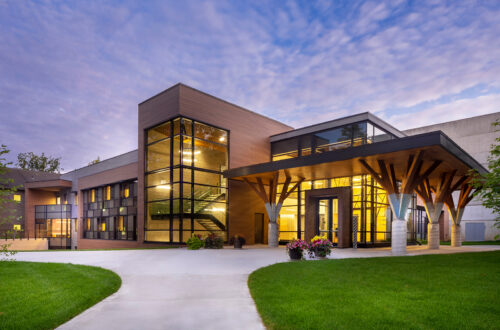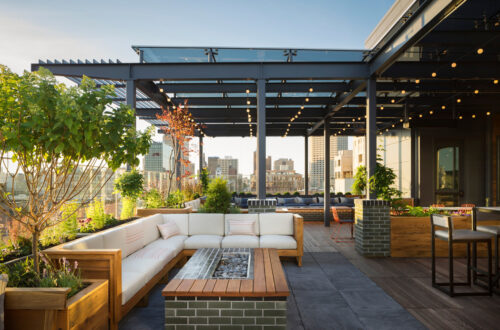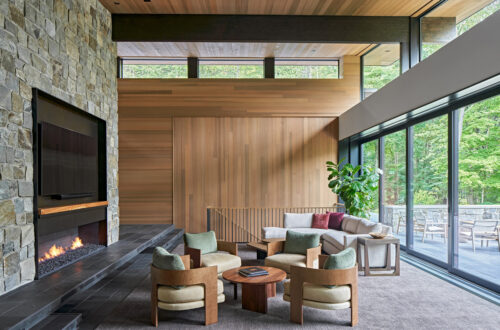In recent years, there has been a growing initiative in urban landscapes to look beyond the imminent tomorrow and reimagine the next generation of public spaces. It is a movement encouraging cities, architects, designers, and urban planners to reclaim underutilized infrastructure and transform it into hybrid spaces of both city and greenspace: parks that also serve as public squares, gardens, transit corridors, and living, moving performance art.
For several public-private partners in Toronto, Ontario, the Frederick G. Gardiner Expressway connecting the downtown city to its surrounding neighborhoods presented the perfect opportunity to posit a new take on the cultural destination and city park. The Gardiner Expressway, which carries thousands of vehicles on its elevated highway corridor daily, was completed in the mid-1960s and extends along the shore of Lake Ontario. While once industrial, the landscape below and near the major transit artery has changed into one decidedly more residential.
Prompted by Judy and Wilmot Matthews, a collaborative team of private and public organizations transformed the space beneath the elevated highway into a new gathering place with year-round activities and events, known as The Bentway. Due to its innovation, reclamation of infrastructure, and Toronto’s commitment to adaptive reuse and public space, the Bentway is also a part of a group of infrastructure projects in partnering cities known as the High Line Network.
“I think the nature of discussion around public space has changed really significantly. In the last century we saw a huge investment in the idea of destination-based public spaces—really grand and big spaces where a city could come together and celebrate itself and like spaces that offered reprieve from the city in many ways,” said Ilana Altman, co-executive director and director of programming at The Bentway in Toronto, Ontario.
Conceptually, The Bentway is an authentic reflection of this new approach to creative and innovative public spaces that can be seen in other High Line Network cities, such as New York City, Los Angeles, Chicago, and Detroit. The multi-phase project leveraged about 1.75 kilometers, or roughly one mile, of existing pillars and concrete columns—or bents—from Strachan Avenue to Bathurst Street to create a connective gateway for seven local neighborhoods to the waterfront, as well as access to places such as Fort York National Historic Site, Ontario Place and Exhibition Place, Harbourfront Centre, and the CN Tower.
With the collaboration of the Matthews, City of Toronto, Waterfront Toronto, Fort York National Historic Site, Artscape, and the design team of Greenberg Consultants and PUBLIC WORK, the first phase of The Bentway officially opened in January 2018 with the debut of The Bentway Skate Trail and completed several months later with the opening at Strachan Gate in August 2018.
“There are a couple of key design elements that make up this part of the project. The first is a multi-use trail for cyclists and pedestrians that run the length of the project and currently the first phase of the project runs between Strachan Ave. on the West and Fort York Blvd. where it curves up underneath the Gardiner on the East,” Altman said. “There is also a series of new landscape elements: it is very lush and green down there in the spring, summer, and fall with lots of new plantings, new grasses, and a very new approach to storm water treatment.”
Integrated into the post-and-beam defining structure of the Bentway is a series of biofils used to filter and treat storm water from the Gardiner Expressway. The nature of the elevated highway, with its varying heights, is also used to create designated areas for specific programming and events, and presents support for technical systems such as power, cables, and lighting. Altman, who in her role as Director of Programming, works with the Toronto communities to create innovative and engaging programming, said it is quite diverse in nature.
In many ways a new type of urban stage, The Bentway’s programming has an intentional depth and breadth. Each winter, a portion of the pathway’s underground refrigeration creates a skating trail on the eastern edge; this summer, the commissioned public art of Communitas: The Spirit of Community explores the gain and loss of unity through August 2019; the recreational classes such as yoga and tai chi, along with a series of communal dining experiences will take place this year as well.
For programming overall, Altman noted the mandate developed for The Bentway recognized the importance of it and to ensure the project remains relevant to the Toronto community, it is necessary to involve artists, partners, and recreational partners—not just animate the space, but also reflect on the nature of the city’s changing landscape.
“It has revalued a piece of urban infrastructure that has divided the city for so long. Toronto hasn’t waited for that piece of infrastructure to become defunct before it decided to make it play another role,” Altman said. “I think it is a testament to a great city that we see an active expressway can also serve as a vibrant public space, and that is really exciting to me.”
Read the full-length feature in Great Lakes By Design: Enriched Motif.
Text: R.J. Weick
Photography, featured image: Nic Lehoux






